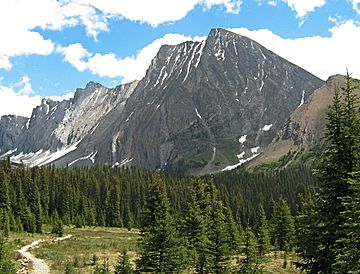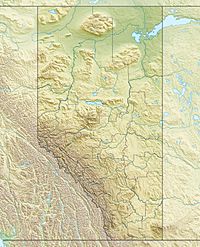Mount Chester facts for kids
Quick facts for kids Mount Chester |
|
|---|---|
 |
|
| Highest point | |
| Elevation | 3,054 m (10,020 ft) |
| Prominence | 341 m (1,119 ft) |
| Geography | |
| Location | Alberta, Canada |
| Parent range | Kananaskis Range |
| Topo map | NTS 82J/14 |
| Climbing | |
| Easiest route | Scramble on southwest face |
Mount Chester is a tall mountain located in the beautiful Kananaskis area of the Canadian Rockies in Alberta, Canada. It stands in the Smith-Dorrien Creek Valley. The mountain was named in 1917. It got its name from a British warship, HMS Chester, which was part of an important naval battle.
Just northwest of Mount Chester, you'll find Chester Lake. It sits in a small valley near the base of the mountain.
How Mount Chester Was Formed: Geology
Mount Chester is made of sedimentary rock. This type of rock forms from layers of sand, mud, and tiny bits of sea creatures that settle at the bottom of ancient seas. Over millions of years, these layers hardened into rock.
The rocks that make up Mount Chester were laid down a very long time ago. This happened during periods known as the Precambrian and Jurassic times. Later, a huge event called the Laramide orogeny occurred. During this time, powerful forces pushed the Earth's crust. This caused the older sedimentary rocks to be lifted and folded, creating the mountains we see today.
Weather and Climate at Mount Chester
Mount Chester has a subarctic climate. This means it has very cold and snowy winters. Summers are usually mild and pleasant. Temperatures can often drop below −20 °C (which is -4 °F) in winter. When the wind blows, it can feel even colder, sometimes below −30 °C (-22 °F).
If you want to visit Mount Chester, the best time for good weather is from July through September. These months offer the mildest temperatures and less snow, making it a great time for outdoor activities like climbing.


